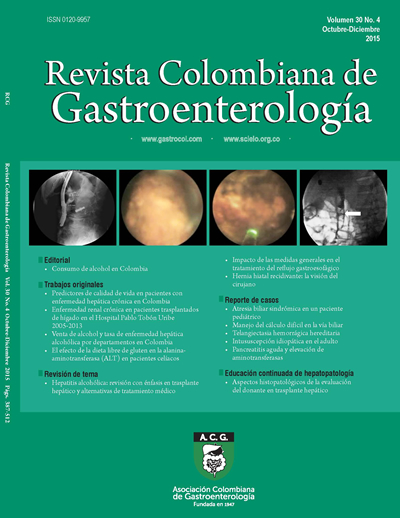Hernia hiatal recidivante: la visión del cirujano. Revisión de la literatura
DOI:
https://doi.org/10.22516/25007440.8Palabras clave:
Hernia hiatal, hernia hiatal recidivante, laparoscopiaResumen
Las hernias hiatales recidivantes constituyen una patología común que generan un reto diagnóstico y terapéu- tico para cirujanos y gastroenterólogos. Generalmente se presentan de forma asintomática o con síntomas atípicos y se asocian a factores fisiológicos, propios del paciente y de la técnica quirúrgica. Su tratamiento es complejo y dependiendo de la causa de los síntomas pueden requerir manejo médico o quirúrgico. En este artículo, se pretenden definir pautas para la identificación y manejo de esta patología, así como establecer claves para el tratamiento desde un enfoque quirúrgico.
Descargas
Referencias bibliográficas
White BC JL, Morgenthal CB, Zagorski S, Davis SS, Smith CD, et al. Do recurrences after paraesophageal hernia repair matter?: Ten-year follow-up after laparoscopic repair. Surg Endosc. 2008;22(4):1107-11.
Coelho JC GC, Claus CM, Andrigueto PC, Ribeiro MN. Late laparoscopic reoperation of failed antireflux procedures. Surg Laparosc Endosc Percutan Tech. 2004;14(3):113-7.
Musunuru SGJ. Perioperative outcomes of surgical proce- dures for symptomatic fundiplication failure: a restrospec- tive case-control study. Surg Endosc. 2012;26(3):838-42.
Smith CD, Rajad MA, Lederman AB, Hunter JG. When fun- doplication fails: redo? Ann Surg. 2005;241(6):861-9.
Oelschlager BK PR, Brunt LM, Soper NJ, Sheppard BC, Mitsumori L, et al. Laparoscopic paraesophageal hernia repair: Defining long-term clinical and anatomic outcomes. J Gastrointest Surg. 2012;16(3):453-9.
Landreneau RJ, Santos R Management of paraesophageal hernias. Surg Clin North Am. 2005;85:411-32.
Oelschlager BK, Hunter JG, Brunt ML, Soper NJ, Sheppard BC, et al. Biologic prosthesis to prevent recurrence after lapa- roscopic paraesophageal hernia repair: long-term follow-up from a multicenter, prospective, randomized trial. J Am Coll Surg. 2011;4:461-8.
Morino M GC, Pellegrino L, Rebecchi F. Laparoscopic management of giant hiatal hernia: factors influencing long- term outcome. Surg Endosc. 2006;20(7):1011-6.
Skinner DB BR. Surgical management of esophageal reflux and hiatus hernia. Long-term results with 1,030 patients. J Thorac Cardiovasc Surg. 1967;53(1):33-54.
Treacy PJ. An approach to the management of para-oesopa- geal hiatus hernias. Aust N Z J Surg. 1987;57:813-7.
Brant K. Oelschlager RBYM. Management of Minimally Symptomatic Recurrent Hiatal Hernia. In: Springer, editor. Difficult Decisions in Thoracic Surgery. 2014. p. 511-28.
Hutter MM. Paraesophageal and other complex diaphrag- matic hernias. In: CJ Y, editor. Shackelford’s surgery of the alimentary tract. Philadelphia: Saunders Elsevier; 2007. p. 549-62.
Edye MB CEJ, Gattorno F, Salky BA Durability of lapa- roscopic repair of paraesophageal hernia. Ann Surg. 1998;228:528-35.
Papasavas PK, Robke J, Raftopoulos Y, Gagné DJ, et al. Laparoscopic repair of large paraeophageal hernia is associa- ted with a low incidence of recurrence and reoperation. Surg Endosc. 2004;18:444-7.
Morcos SK. Review article: Effects of radiographic contrast media on the lung. Br J Radiol. 2003;76(905):290-5.
Curci JA ML, Thompson RW, Soper NJ, Matthews BD. Elastic fiber depletion in the supporting ligaments of the gastroesophageal junction: a structural basis for the gastroe- sophageal junction: a structural basis for the development of hiatal hernia. J Am Coll Surg. 2008;207:191-6.
Beglaj SM. Paraesophageal hernia in children: familial occurrence and review of the literature. Pediatr Surg Int. 1999;15:85-7.
Geoffrey PK RR, Steven RD, Jorg Z, Oliver JM, Zuad A, et al. Guidelines for the management of hiatal hernia. Surg Endosc. 2013;27:4409-28.
MattarSG,GallowayKD,HunterJG,SmithCD.Long-term outcome of laparoscopic repair of paraesophageal hernia. Surg Endosc. 2002;16(5):745-9.
Hashemi M PJ, DeMeester TR, Huprich JE, Quek M, Hagen JA, et al. Laparoscopic repair of large type III hiatal hernia: objective followup reveals high recurrence rate. J Am Coll Surg. 2000;190(5):553-60.
Perez AR, Rattner DW Obesity adversely affects the outcome of antireflux operations. Surg Endosc. 2001;15:986-9.
Aly A, Jamieson GG, Ludemann R, Devitt PG, Watson DI. Laparoscopic repair of large hiatal hernias. Br J Surg. 2005;92:648-53.
Shamiyeh A, Granderath FA, Syre G, Wayand W, Zehetner J. The esophageal hiatus: what is the normal size?. surg Endosc. 2010;24:988-91.
Braghetto I, Csendes A, Burdiles P, Valladares H, Brunet L Postoperative results after laparoscopic approach for treatment of large hiatal hernias: is mesh always needed? Is the addition of an antireflux procedure necessary?. Int Surg. 2010;95:80-7.
Low DE. Effect of paraesophageal hernia repair on pulmo- nary function. Ann Thorac Surg. 2002;74:333-7.
Awais O. Management of giant paraesophageal hernia. Minerva Chir. 2009;64:159-68.
Hunter JG, Branum GD, Waring JP, Trus TL, Cornwell M, et al.
Laparoscopic fundoplication failures: patterns of failure and response to fundoplication revision. Ann Surg. 1999;230:595-604.
Cardile AP. Gastric volvulus, Borchardt’s triad, and endos- copy: a rare twist. Hawaii Med J. 2011;70:80-2.
Eren S, Okur A. A rare cause of intestinal obstruction in the adult: Morgagni’s hernia. Hernia. 2003;7:97-9.
Gourgiotis S, Germanos S, Baratsis S. Acute gastric volvu- lus: diagnosis and management over 10 years. Dig Surg. 2006;23:169-72.
Swanstrom LL, Kinzie LR, Horvath KD. Esophageal motility and outcomes following laparoscopic paraesophageal hernia repair and fundoplication. Am J Surg. 1999;177:359-63.
Boushey RP, Burpee S, Schlachta CM, Poulin EC, Haggar F, et al. Laparoscopic repair of paraesophageal hernias: a Canadian experience. Can J Surg. 2008;51:355-60.
Shafii AE, Zervos EE. Perforated gastric corpus in a stran- gulated paraesophageal hernia: a case report. J Med Case Reports. 2009;3:6507.
Parker DM, Johanson K, Ibele A, Gabrielsen JD, Petrick AT. Urgent laparoscopic repair of acutely symptomatic PEH is safe and effective. Surg Endosc. 2013;27(11):4081-6.
Spaniolas K, Adrales GL, Trus TL. Laparoscopic parae- sophageal hernia repair: advanced age is associated with minor but not major morbidity or mortality. J Am Coll Surg. 2014;218(6):1187-92.
Che F, Cohen A, Nguyen NT. Prevalence of hiatal hernia in the morbidly obese. Surg Obes Relat Dis. 2013;9(6):920-4. 37. Pandolfino JE, El-Serag HB, Zhang Q, Shah N, Ghosh SK, Kahrilas PJ. Obesity: a challenge to esophagogastric junction integrity. Gastroenterology. 2006;130(3):639-49. 38. Chaudhry UI, Marr BM, Osayi SN, Mikami DJ, Needleman BJ, Melvin WS, et al. Laparoscopic Roux-en-Y gastric bypass for treatment of symptomatic paraesophageal hernia in the morbidly obese: medium-term results. Surg Obes Relat Dis. 2014;10(6):1063-7.
Mahawar KK, Jennings N, Balupuri S, Small PK. Simultaneous Sleeve Gastrectomy and Hiatus Hernia Repair: a Systematic Review. Obes Surg. 2014;19(6):761-3. 40. Jobe BA AR, Deveney CW, Domreis JS, Hill LD. Laparoscopic management of giant type III hiatal hernia and short esophagus. Objective follow-up at three years. J Gastrointest Surg. 2002;6(2):181-8.
Descargas
Publicado
Cómo citar
Número
Sección
Licencia
Aquellos autores/as que tengan publicaciones con esta revista, aceptan los términos siguientes:
Los autores/as ceden sus derechos de autor y garantizarán a la revista el derecho de primera publicación de su obra, el cuál estará simultáneamente sujeto a la Licencia de reconocimiento de Creative Commons que permite a terceros compartir la obra siempre que se indique su autor y su primera publicación en esta revista.
Los contenidos están protegidos bajo una licencia de Creative Commons Reconocimiento-NoComercial-SinObraDerivada 4.0 Internacional.



















